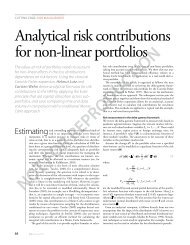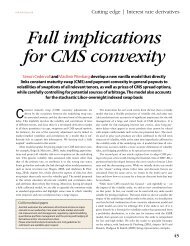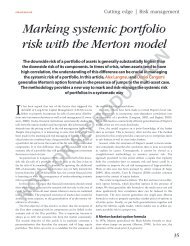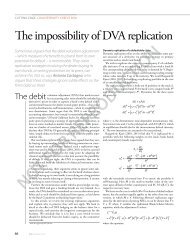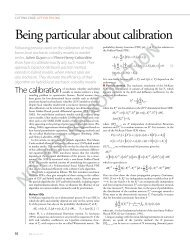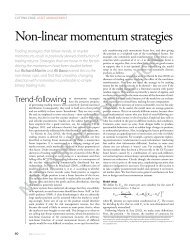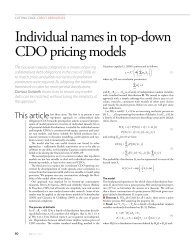Modeling drawdowns and drawups in financial markets - Risk.net
Modeling drawdowns and drawups in financial markets - Risk.net
Modeling drawdowns and drawups in financial markets - Risk.net
You also want an ePaper? Increase the reach of your titles
YUMPU automatically turns print PDFs into web optimized ePapers that Google loves.
62<br />
Beatriz Vaz de Melo Mendes <strong>and</strong> V<strong>in</strong>icius Ratton Br<strong>and</strong>i<br />
tions. For the IBOVESPA, the str<strong>in</strong>gs of consecutive ga<strong>in</strong>s are longer than those<br />
of consecutive losses <strong>and</strong> may result <strong>in</strong> extreme cumulative ga<strong>in</strong>s.<br />
The longest duration observed correspond to 19 consecutive ga<strong>in</strong>s of the<br />
Nasdaq. Nasdaq also showed the smallest frequency of ga<strong>in</strong>s of duration one day,<br />
<strong>and</strong> the highest frequency of consecutive losses <strong>and</strong> ga<strong>in</strong>s last<strong>in</strong>g more than 15<br />
days.<br />
In Table 3 we present results from the MGPD <strong>and</strong> the stretched exponential fits.<br />
This table gives the parameters maximum likelihood estimates <strong>and</strong> the log-likelihood<br />
value for each model. For the sake of brevity, we do not report the results<br />
from the statistical tests. The estimates of ξ <strong>and</strong> γ suggest that, for most <strong>in</strong>dexes,<br />
<strong>drawdowns</strong> possess heavier tails than <strong>drawups</strong>. 7 An exception is the IBOVESPA,<br />
whose <strong>drawups</strong> possess the heavier tail among all <strong>in</strong>dexes, as <strong>in</strong>dicated by the<br />
estimate of the shape parameter, ˆ ξ = 0.35.<br />
As noted by Johansen <strong>and</strong> Sor<strong>net</strong>te (2001), extreme (larger than 10%) <strong>drawdowns</strong><br />
<strong>and</strong> <strong>drawups</strong> from the three US <strong>in</strong>dexes, showed a strong departure from<br />
the stretched exponential. The full MGPD model provided a better fit for them <strong>and</strong><br />
the statistical tests strongly rejected the stretched exponential.<br />
Figure 3 shows QQ-plots based on the Nasdaq <strong>drawdowns</strong> <strong>and</strong> <strong>drawups</strong> fits. In<br />
this figure the reference distribution is the MGPD for the two upper plots, <strong>and</strong> the<br />
stretched exponential for the two lower plots. At the left-h<strong>and</strong> side, we can see that<br />
the five large <strong>drawdowns</strong> outliers observed on the stretched exponential fit do not<br />
seem to be so atypical under the MGPD model. The MGPD fitted the moderately<br />
large <strong>drawups</strong> well <strong>and</strong> po<strong>in</strong>ted out a s<strong>in</strong>gle outlier (right-h<strong>and</strong> side). We note that<br />
this largest observation had not shown up as an outlier under the stretched exponential<br />
model (bottom right). This phenomenon is well known <strong>in</strong> robustness as the<br />
mask<strong>in</strong>g effect (Rousseeuw <strong>and</strong> Leroy, 1987).<br />
For the <strong>drawdowns</strong> from the Dow Jones, the stretched exponential fit detected<br />
one large <strong>and</strong> five moderately large outliers. The MGPD also found the large<br />
outlier, but fitted the rema<strong>in</strong><strong>in</strong>g data po<strong>in</strong>ts well. For the <strong>drawups</strong> from the Dow<br />
Jones the stretched exponential provided a nice fit only for <strong>drawups</strong> with size up<br />
to 6%, whereas the MGPD gave a good fit to all data, spott<strong>in</strong>g only the largest<br />
observation.<br />
In the case of the S&P500, the stretched exponential provided a poor fit for<br />
<strong>drawdowns</strong> smaller than –8% <strong>and</strong> for <strong>drawups</strong> greater than 8%. The MGPD<br />
found one extreme <strong>and</strong> one large drawdown outlier <strong>and</strong> gave a good fit to <strong>drawups</strong><br />
up to 14%, detect<strong>in</strong>g just two moderately large outliers.<br />
Johansen <strong>and</strong> Sor<strong>net</strong>te (2001) found that <strong>drawdowns</strong> from CAC40 are almost<br />
perfect exponential. Our results shown <strong>in</strong> Table 3 confirm this statement. The<br />
QQ-plots <strong>in</strong>dicated two <strong>drawups</strong> outliers.<br />
The Hang Seng <strong>in</strong>dex is another nice example that improvements may be<br />
achieved by us<strong>in</strong>g the MGPD distribution. The stretched exponential fit on the<br />
7 It seems there might be a connection between the value of the modify<strong>in</strong>g parameter γ <strong>and</strong><br />
the duration of a drawdown. This requires a more comprehensive <strong>in</strong>vestigation.<br />
URL: www.thejournalofrisk.com Journal of <strong>Risk</strong>




